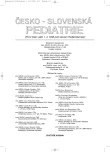Associations between Parental and Children’s Injuries
Authors:
L. Kukla 1,2; M. Bouchalová 1
Authors‘ workplace:
Výzkumné pracoviště preventivní a sociální pediatrie, LF MU Brno
vedoucí doc. MUDr. L. Kukla, CSc.
1; Katedra klinických oborů, ZSF JČU, České Budějovice
vedoucí doc. MUDr. V. Adámková, CSc.
2
Published in:
Čes-slov Pediat 2008; 63 (3): 126-136.
Category:
Original Papers
Overview
Aim of the study:
To help in prevention of children´s injuries by comparing them with parental injury morbidity. To investigate whether such a relation exists at all – if yes, whether the relations are the same in boys as well as in girls, and whether they change during their progressing age or not.
Methods:
According to numbers of their injuries before and five years after the birth of their children, the parents were divided into four categories: without any injury and with low, medium, and high numbers of them. Injuries of their children in age periods 0–3, 3–5, 5–7 and 7–11 years as well as during cummulated periods of 0–7 and 0–11 years were compared between parental categories.
Results:
Injuries of children were directly and closely associated with the parental ones. Between the offspring of parents with no injury and of the parents with medium or high numbers of injuries, significant differences have been found in injury incidence per 100 children and in the rate of injury repeaters, gradually increasing on the parental scale. In the same direction, the rate of injury – free children decreased. During preschool age, these relations grew stronger, in school age they seemed to get stabilized. Up to 5 years of age, they were more evident in girls and later – namely in cummulative age periods, they were stronger in boys.
Conclusion:
Parental injuries are significant risk factor(s) for injury morbidity of their children: prevention of parental injuries is the best prevention of injuries for their offspring. The cause of this phenomenon is not clear, beside the life style and social environment shared by both generations, it might be some processes not yet investigated in families, eg. of metabolic or neurobiolocal nature that are common in both generations.
Key words:
children´s and parents´ injuries, associations between generation, relative risks, longitudinal study, epidemiology of injuries
Sources
1. Kukla L, Bouchalová M, Stejskal J, et al. Epidemiologická studie celoživotní úrazovosti v populaci produktivního věku. Brno: Výzkumná zpráva VÚZD, 1995: nepublikováno.
2. Lopez AD, Mathers CD, Ezzati M, et al. Global and regional burden of disease and risk factors, 2001: systematic analysis of population health data. Lancet 2006;367 : 1747–1757.
3. Bouchalová M, Kukla L. Úrazovost v dětství. Čes.-slov. Pediat. 1994;3 : 176–181.
4. Marušič A, Musek J, Gudjonson G. Injury proneness and personality. Nord. J. Psychiatry 2001;55 : 157–161.
5. Spady DW, Saunders DL, Schopflocker DP, et al. Patterns of injury in children: a population-based approach. Pediatrics 2004;3 : 522–529.
6. Grivna M, et al. Dětské úrazy a možnosti jejich prevence. Praha: Centrum úrazové prevence UK 2. LF a FN Motol, 2003.
7. Research Protocol of European Longitudinal Study of Pregnancy and Childhood (ELSPAC). Paediatric and Perinatal Epidemiology 1989;3 : 460–469.
8. Göpfertová D, et al. Epidemiologie. Praha: Triton, 1999.
9. Pelech L, Roth Z, Zvadová Z. Úrazovost dětí mladšího školního věku. Čes.-slov. Pediat. 1996;12 : 715–724.
10. Pelech L, Roth Z, Zvadová Z. Úrazy a děti. Čas. Lék. čes. 1998;15 : 460–463.
11. Pelech L, Roth Z, Tošovský V, et al. Úrazová incidence u starších školních dětí. Čes.-slov. Pediat. 1998;53 : 156–158.
12. Pelech L, Roth Z. Školní a dospívající mládež a dopravní úrazovost. Hygiena 1998;3 : 141–146.
13. Pelech L, Roth Z, Zvadová Z, et al. Analýza úrazovosti dospívající mládeže. Čes.-slov. Pediat. 1999;10 : 556–561.
14. Zvadová Z, Janoušek S, Roth Z. Incidence úrazovosti u dětí předškolního věku. Čes.-slov. Pediat. 2001;6 : 349–354.
15. Janoušek S, Zvadová Z, Roth Z. Socioekonomická podmíněnost dětské dopravní úrazovosti. Čes.-slov. Pediat. 2007;3 : 123–132.
16. Carter YH, Jones PW. Accidents among children under five years old: a general practice based study in North Staffordshire. British Journal of General Practice 1993;43 : 159–163.
17. Brudvik Ch. Child injuries in Bergen, Norway. Injury Int. J. Care Injured 2000;31 : 761–767.
18. Bouchalová M. Vývoj během dětství a jeho ovlivnění. Brněnská růstová studie. Praha: Avicenum, 1987.
19. Carlson KF, Langer D, Alexander BH, et al. The association between parents´past agricultural injuries and their children´s risk of injury. Analysis from the Regional Rural Injury Study II. Arch. Pediatr. Adolesc. Med. 2006;160 : 1137–1142.
20. Gerberich SD, Gibson RF, French LR, et al. Injuries among children and youth in farm households: Regional Rural Injury Study I. Injury Prevention 2001;7 : 117–122.
21. Wazana A. Are there injury – prone children? A critical review of the literature. Can. J. Psychiatry 1997;42 : 602–620.
22. O´Connor TG, Davies J, Golding J, and ALSPAC Study Team. Distribution of accidents, injuries and illnesses by family type. Pediatrics 2000;106(5): E68. PMID: 11061805 (PubMed – indexed for MEDLINE).
23. Reading R, Langford IH, Haynes R, et al. Accidents to preschool children: comparing family and neighbourhood risk factors. Social Science and Medicine 1999;48 : 321–330.
24. Haynes R, Reading R, Gale S. Household and neighbourhood risks for injury to 5th–14th year old children. Social Science and Medicine 2003;57 : 625–636.
Labels
Neonatology Paediatrics General practitioner for children and adolescentsArticle was published in
Czech-Slovak Pediatrics

2008 Issue 3
- What Effect Can Be Expected from Limosilactobacillus reuteri in Mucositis and Peri-Implantitis?
- The Importance of Limosilactobacillus reuteri in Administration to Diabetics with Gingivitis
Most read in this issue
- Tularaemia: Rare Cause of Fever and Lymphadenopathy in an Infant
- Plasmapheresis and Immunoadsorption in Pediatrics
- Czech Atherosclerosis Society Guidelines for the Diagnosis and Treatment of Dyslipidemias in Children
- Kawasaki Disease (40th Anniversary of the First Publication)
